MUSICAL INSTRUMENT OF MYANMAR
Myanmar Travel Information 2017
A "harp" is called Saung in Myanmar. There basically was 2 types: Byat Saung and Saung Gauk (bent harp). There almost is nobody who can play byat saungs these days. Today saung generally refers to the bent harp illustrated above.
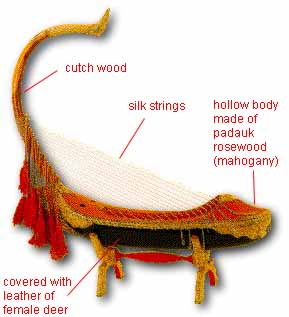
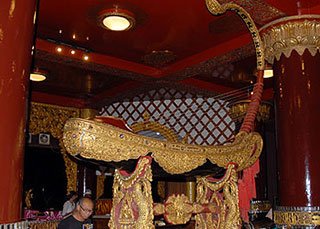
In 10th century AD. musicians used only 5 strings in Myanmar harp. which later increased to 7 strings in 18th century. During King Bodaw Pharar the art of playing harp was much promoted by the king and was improved to using up to 13 strings.
Composition of a Myanmar Harp Can you imagine how it is made of? The composition of Myanmar harps is very interesting. The body is made of padauk. the famous Myanmar mahogany. The flat bar is made of cutch wood. It is covered with the leather of a female deer. And the strings are made of silk!
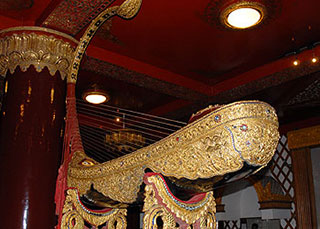
The Bamboo Xylophone (or) the Pattalar that is known in Myanmar language as an ancient musical instrument with the sound box underneath. with the seven graduated keys. it can produce melodious and unique sounds to the ears. Later on. ten keys were added and nowadays. 24 keys are being used. The name pattalar means a musical instrument on which you can play from the crescendo to the bases or from the base to the crescendo. Whichever the musical has to be played and when you play the xylophone. you need two sticks wrapped around with the cloth at the top which can produce harmonious melody or sound. To make a bamboo xylophone. first. you must split the Waboe bamboo into four parts and then immerse it in the mud. about a year and then you have to wash it thoroughly and later on. you have to smoke it for a year. So. the bamboo becomes seasoned. The seasoned bamboos are cut into slats which are smoothened out. polished and made in a left to right position where 22 bamboo slats are sandwiched with the largest slates which are one and half feet and shortest is 6 inches respectively.
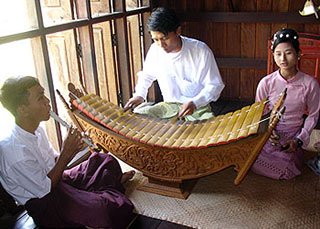
Later on. the slates are drilled with the holes so that the string. which will hold them together and can be passed through. In this way. the Myanmar musical instrument bamboo xylophone is made. There are seven musical keys in the Western musical note. Also Myanmar Pattala has seven musical keys. which are reproduced from the sounds of animals and also from Myanmar Oboe. which has seven holes. In the ways. we can see Myanmar musical instruments are differ in shape and tone from western musical instruments but they all have the same musical notes. which all the musician can understand and appreciate.
SHAN OSI (SHAN LONG DRUM)
Stone Drum: This actually is not a musical instrument. We just present it to you for its peculiarity. Isn't it so strange to find a drum made of stone? You can ring it. It is somewhat a flat piece of rock. usually hanged around pagodas or monasteries. The purpose of using these is just like using bells. so that people can ring it by hitting with a stick.
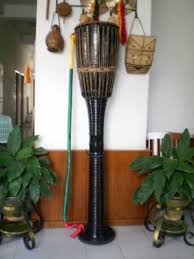

About the Musical Instruments
There are five kinds of musical instruments, namely, kyay ( alloy containing copper ), kyo ( strings), tha-yay(hide), lay (air) and lekkoke (clapper). Myanmar musical instruments can be further categorized into two kinds, such as concert ( anyeint) and orchestra ( saing-waing).
As a matter of fact. many musical instruments were invented and fell into disuse throughout the ages of successive Pyu. Bagan (1044-1298 AD). Pinya (1299-1363 AD). Inwa (1364-1516 AD). Taungoo (1537-1598 AD). Nyaung Yan (1597 – 1751 AD). and Kongbaung (1752 – 1885 AD) dynasties.
The anyeint ( concert of chamber ) musical instruments of the past were and some of them still are the boat-shaped harp, alligator- guiltar, violin, xylophone, flute, oboe, saniara ( stringed. extinct ), aung galay( stringed. extinct ), don-min ( dulcimer-like or air. extinct ), hnyin(reed pipes. extinct), than-lwin ( small cymbals) etc. However, only six instruments were prescribed for anyeint. the intimate musical entertainment of the royal chambers.
The Myanmar music ensemble is not the "orchestra" in the true sense of the term "orchestra". The "orchestra" now means the full array of strings. wood-winds. brass and percussion instruments performing Western music in fromt of and under the direction of the conductor.
The Myanmar orchestra is spectacular in appearance and unique in the musical tone it produces. In the Myanmar saing-waing orchestra. the stringed instruments and also the xylophone are absent. their use being confined to concert performances.
First and foremost of the saing-waing orchestra is the drums-circle ( pat – waing ) a group of twenty-one drums of different sizes arranged in a circular order which make the tune. The brass gongs-circle ( kyee-naung waing. sharp – toned) and the bronze gongs ( maung waing. mellow-toned ) support the "drums-circle". Actually, the left-hand and right-hand combinations and permutations of the players of the three instruments are almost identical.
The leader of the saing-waing orchestra is the player of the drums-circle who is always courteously addressed as ywar-sar ( literally. eater of a village). that is . Lord of a village. The ywar-sars of those days were appointed by the Myanmar kings to rule big and prosperous villages in their stead and they did enjoy revenues of the villages under their jurisdiction.
The tympant corner ( pat-ma – gyaung) consists of the " big drum "( pat-ma-gyi). held up from above by the enormous figure of a mythical "Phinsa-Rupa "meaning an animal with different parts of five animals. the medium-sized wupport – drum ( sea-khunt ). the six smaller base drums ( chauk – lone-pat ) and the stick-struck drum ( si-doh). Its companions are two pairs of big and medim-sized cymbals ( lin-kwin ). the small tempo-keeping cymbals ( than-lwin). the hollowed-out wooden block or hollowed-out giant bamboo with closed ends and the irrepressible bamboo clappers ( warlekkoke). The drums-circle and the brass gongs- circle are housed in circular frames. The circumference of the drums-circle is about 5 meters and it is 80 cm high.
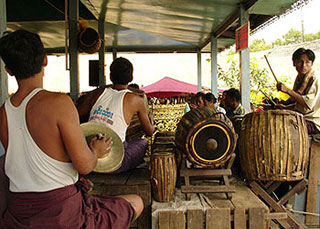
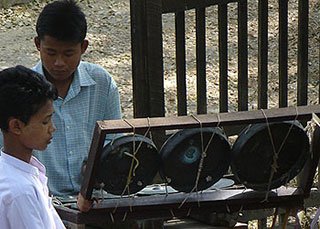
The brass gongs-circle is smaller. about 55 cm high and approximately two thirds the circumference of the circular frame for the drums – circle. The bronze gongs. in contrast. are suspended by means of ropes between five wooden frames. three of which are placed flat on a box; the other two. the largest ones. are set upright.
The drums except the si-soh are all tuned by certain amounts of pat-sa ( drum-feed ) which is a mixture of wood-ash and cooked rice kneaded thoroughly. The dough-like mixture is stuck onto the centres of the ox-skin surfaces. To lower the tone. add more. To raise the tone. remove little by little and tidy up with wet finger or thumb. Sometimes. with the change of weather. the gongs also raise or lower their tuning. They are then retuned by hammering them ( bronze ones) or by applying bees wax and lead fillings inside the hollow of the bosses ( brass ones ).
The highest measure of art of the saing-musicians. particularly that of the drums-circle player. is to perform for a dramatic troupe. Whereas Moha Guta plays an indispensable role in Myanmar saing-music. the Myanmar saing-music plays an important part in the Myanmar drama. Myanmar saing-music had to join hands with the Myanmar theatre. and in the course of the parallel development. conventional patterns of the " expression "of emotions and dramatic situations came into being. Our music produced by our saing-orcestra does express them in its own way although it is not the way of the operas and musicals of the West. The moods of our plays are matters of conventions with fiexed conventional passages or musical pieces for lthe orchestra. such as. lay-kin and bein-maung for storms. flights. flights. pursuit and commotions; ngo-chin or ah-pu taik for grief. despair and weeping; chute for stealth; bone-tauk for happiness and jollity; baw –lei and hmaing for celestials; nat-doe for evil spirits; wai-tar for water crafts and swimming; hunget-hyi for keineras etc. These dramatic ( musical ) conventions had firmly embedded into our consciousness since childhood so much so that we just " enjoyed " a scene of pathos when the hero ( mintha ) or the heroine (minthamee) started singing ngo-chin ( wailing song ) in vibrant strain and at the end the orchestra crashed in crescendo with the big pat-ma beating vigorously in fortissimo most probably in synchronisation with heart-beats of the tear-jerker loving theatre-goers.
For us people of Myanmar. it is a matter of national pride to learn that our ancestors had that much standard of music and that much quantity of musical instrument.
hello nice to meet you!!!
me too
Congratulations @soeminphyo! You have completed some achievement on Steemit and have been rewarded with new badge(s) :
Click on any badge to view your own Board of Honor on SteemitBoard.
For more information about SteemitBoard, click here
If you no longer want to receive notifications, reply to this comment with the word
STOPက်ားသစ္ထိထားလို႔ မဘုတ္ခဲ့ေတာ့ဘူး